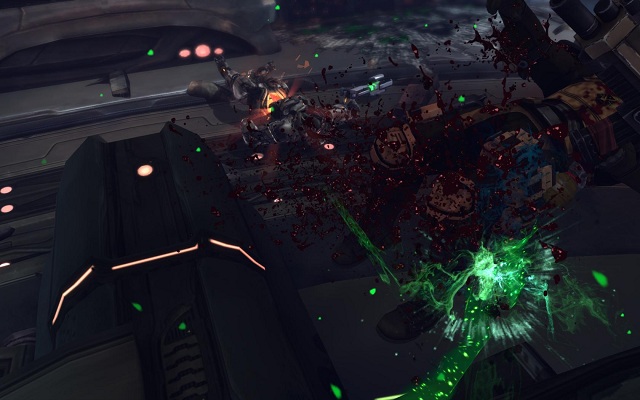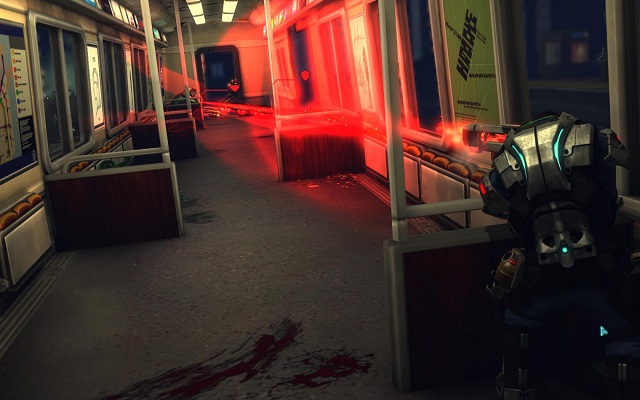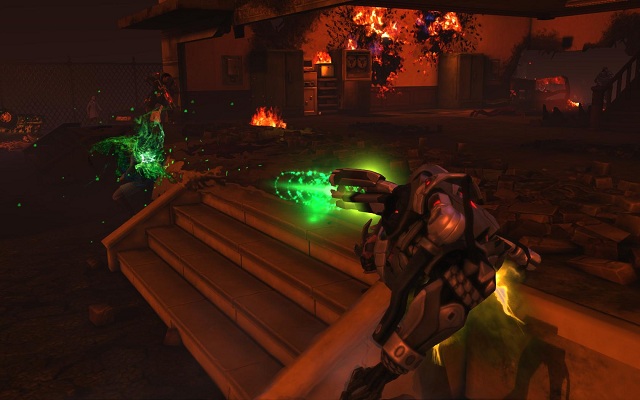WHAT YOU WON’T LIKE
Bringing the original X-Com into this modern era of game design obviously necessitates some tweaks. Unfortunately, Firaxis’ efforts may have gone a little too far in a few places.
Tactical missions feel more “gamey” and less stimulated
Everything starts out fine. Your squad awaits your command. But as you jump from cover to cover searching for aliens, the game might treat you to a sort of “sound wave” clearly pointing in a particular direction. Your soldier might interject, “Shh! Did you hear that? I don’t think we’re alone.”
Enemy Unknown wants you to think that you’re hearing enemies moving outside your soldiers’ vision and getting ready to strike at your position. Unfortunately, the curtain comes down as soon as you encounter them.
Aliens run in packs of two or three, and you’ll soon realize this because you’ll often see a group of just this size sitting in a circle as if it’s waiting for you to show up. You’ll get a cinematic reveal of your foes … and then they all get a free move to cover during your turn! What the hell, Firaxis? (Although you can exploit this to your advantage because while they can move during your turn, soldiers in Overwatch can take reaction shots during your own turn. Yes, it’s as odd as it sounds.)
Every time I come across a pack of Martians in this fashion, the immersion immediately breaks. The sound wave is not the detection of aliens scratching around in the dark at all. It’s the game telling me exactly which direction to travel to reach my opponents. Ugh.
Contrast this to Silent Storm, another turn-based squad-level tactics game, which employs a real stimulated sound system. It would even place silhouettes of enemies in suspected locations based on what your own troops had heard. The sound wave in Enemy Unknown has the benefit of solving the hidden last alien problem; however, Firaxis has left the cat-and-mouse hunt of the older games in the series behind in favor of a straight-up firefight.
Handcrafted maps
Firaxis assured everyone in the weeks and months before the Enemy Unknown releases that players wouldn’t see the same map in two separate playthroughs. I’ve been down this road before with another X-Com spiritual successor, UFO: Extraterrestrials. Developer Chaos Concepts claimed the same thing regarding its decision to ditch procedurally generated terrain.
Chaos Concepts was blowing smoke then, and Firaxis is blowing smoke now. You will see the same battlefields all the time in a single campaign.
And yes, I understand that enemy spawn locations will change or that my squad might start at a different edge of the tactical space (although they almost always come off the Skyranger dropship in the same location). That doesn’t matter. It’s still the same map. It’s the same office building with the same cars parked in the same places outside the same front door.
This absolutely affects replayability. Seeing the same maps over and over can really zap your will to continue forward. Randomized locations keep you on your toes and offer enough variety to make every encounter feel 100 percent unique. Enemy Unknown needs something like this purely because you’re going to fight a lot of these missions in a single campaign. Such variety keeps everything feeling fresh.
Limited destructive capabilities
Thankfully, fully destructible terrain is in; unfortunately, Enemy Unknown doesn’t make use of a fully simulated physics system. Sure, the original X-Com didn’t, either, but that was two decades ago. And the followup, Apocalypse, did implement such functionality, which led to all kinds of tactically interesting scenarios. Aliens in a top-level building window giving you trouble? Let’s see how they survive the fall once you destroy the support pillars and bring the whole structure down!
Even more disappointing, though, is that only a handful of weapons allow you to freely aim at anything on the map: explosives like grenades and rockets. Everything else requires a specific extraterrestrial target to be visible first. This results is less overall mayhem during a mission as firefights devolve into trading shots from cover instead.
Certainly, limiting the destructive capabilities to a handful of single-use weapons and items makes that equipment more tactically important, but part of the joy of wreaking unfettered havoc on the landscape is lost in the process.
CONCLUSION
Enemy Unknown might have taken a few shortcuts, but these digressions are minor in comparison to what else it accomplishes as a game. The focus on meaningful, ambiguous decisions and then the determination to follow through with forced consequences is an achievement of design worthy of praise.
In no other game will you command an secret, international organization trying to stop a global alien invasion. In no other game will you direct research, manufacture the technologies you discover into useable equipment for your tactical squads in the field, and then lead those soldiers in battle. In no other game will the strategic choices you make intertwine so integrally with your tactical prowess. It’s a feedback loop between two seemingly disparate genres, and it works. The scope of Enemy Unknown is immense, both thematically and mechanically.
In these ways, Enemy Unknown is peerless in modern game design.
Score: 85/100
XCOM: Enemy Unknown releases Oct. 9 for PC, PlayStation 3, and Xbox 360. Publisher 2K Games provided GamesBeat with a Steam download code for the purpose of this review.
VentureBeat's mission is to be a digital town square for technical decision-makers to gain knowledge about transformative enterprise technology and transact. Learn More



